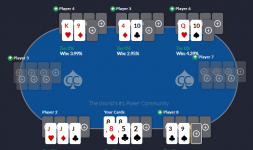CRStals
Moderator
Moderator
In Stud High/Low, scooping—winning both the high and low pots—is the ultimate goal. While chopping (splitting pots) is common, optimizing your strategy to scoop can significantly boost your winnings. This guide enhances your hand selection, opponent reading skills, and overall approach to increase your scooping potential.
Stud High/Low vs. Omaha High/Low: Key Differences
Hand Selection: Aiming for the Scoop
Winning only half the pot isn't sustainable. Prioritize hands that can win both the high and low. Wheel cards (A-5) are your best friends, crucial for both high and low potential. Reclassify cards to refine your strategy:
Reading Opponents: Adapting on the Fly
Your opponents' visible cards dictate your plan of attack from third street to showdown. Consider these questions:
Analyzing the Odds
Imagine this situation:

Scoop Potential
To scoop both pots, you’d need to make a full house or quads. However, this assumes your opponent doesn’t already have a buried pair or hit one on sixth or seventh street. If you hit your outs and scoop, the payoff is huge—but if you miss and draw a face card on sixth street, it’s time to consider folding. bluffing in this situation is unlikely to succeed unless you’re confident your opponent can be pressured into folding (refer back to bluffing strategies discussed earlier).
Putting it all together:
Declaring (Live Games)
In some live Stud High/Low games, players are required to declare which pot(s) they are playing for—high, low, or both—before the showdown. This adds an extra layer of strategy and risk to the game, as declaring incorrectly can cost you the entire pot. Understanding these rules is crucial to avoid costly mistakes.
How Declaring Works
When you declare for both pots, you must win both the high and low pots outright to scoop. If you fail to win both, you walk away with nothing—even if your hand qualifies for one of the pots. This makes declaring both a high-risk, high-reward decision.
Example Scenario
Let’s break down a real-world example to illustrate how declaring impacts outcomes:
Online vs. Live Games
Thankfully, when playing Stud High/Low online, you don’t need to declare what pot you’re playing for—the system automatically evaluates your hand for both high and low pots. However, in live games, house rules may require declarations before showdown. Here are two common approaches:
Key Takeaways
Stay Tuned!
In our 7th and final installment in this Stud vs. Razz series, we will delve into hands you want post-3rd street, and how to read your opponents hands. Make sure you subscribe to the Learning Series index linked below to know when the next series drops!
Keep Learning!
Dive into all our CardsChat Learning Series topics! You can find a catalog of installments here: CardsChat Learning Series. Read-up, and jump in the discussions! Your questions or expertise help us all learn from one another.

Stud High/Low vs. Omaha High/Low: Key Differences
- Omaha H/L: The shared community board clarifies the possibility of a low hand early on. If the board shows three or more low cards, a low hand is almost guaranteed to be in play. You can only use two of your four down cards.
- Stud H/L: With three down cards and unique cards for each player, the chances of a low hand being in play increase dramatically. Any player showing two cards eight or lower is eligible for the low pot.
Hand Selection: Aiming for the Scoop
Winning only half the pot isn't sustainable. Prioritize hands that can win both the high and low. Wheel cards (A-5) are your best friends, crucial for both high and low potential. Reclassify cards to refine your strategy:
- Wheel Cards: A-5
- Lower Cards: 6-8
- Face Cards: 9-K
- Scoop: Target both pots with three wheel cards, three suited cards (including an ace), or three connected cards that also play for low.
- High: Playable with three suited or connected face cards, a set, or a pair.
- Low: Three wheel or lower cards that aren't suited or connected.
- Fold: Proceed cautiously with weak combinations—a mix of wheel, lower, and face cards without strong potential. For example, a four, a nine, and a jack.
Reading Opponents: Adapting on the Fly
Your opponents' visible cards dictate your plan of attack from third street to showdown. Consider these questions:
- How many players appear to have high hands, and how many appear to have low hands?
- Which folded cards could impact other players' hands or your own?
- Scenario 1: You hold three wheel/lower cards with an eight showing, and everyone else seems to be playing for high. Bet aggressively to build the pot, as you're likely the only one playing for low. Ideally, be aggressive with at least three players until fifth street.
- Scenario 2: You start with trip eights. Half the table shows face cards, while the other half shows wheel cards. You have competition for both high and low. If another player hits a better three-of-a-kind than you, consider folding. You can't bluff your way to the low if you are heads up against someone playing for the high hand.
Analyzing the Odds
Imagine this situation:

- High Hand Outs: One eight, three fives, three twos → 7 outs.
- Low Hand Outs: Four aces, three threes, three fours, four sixes, four sevens → 18 outs.
- Odds of hitting a low card on sixth street = 18/36 (50%).
- Odds of hitting another low card on seventh street = 17/35 (~48.6%).
- Combined odds = (18/36) × (17/35) ≈ 24%.
Scoop Potential
To scoop both pots, you’d need to make a full house or quads. However, this assumes your opponent doesn’t already have a buried pair or hit one on sixth or seventh street. If you hit your outs and scoop, the payoff is huge—but if you miss and draw a face card on sixth street, it’s time to consider folding. bluffing in this situation is unlikely to succeed unless you’re confident your opponent can be pressured into folding (refer back to bluffing strategies discussed earlier).
Putting it all together:
- Opponent Visibility Matters: Pay close attention to what your opponents are showing. Their visible cards can drastically impact your odds and strategy.
- Adapt as the Hand Evolves: Be prepared to shift your focus between high and low pots depending on how the cards fall.
- Induce Folds: The best-case scenario is winning without a showdown. Showing strength and forcing opponents to fold can secure the entire pot.
- Scooping vs. Chopping: Winning both pots is always better than splitting them—prioritize hands with scooping potential whenever possible.
Declaring (Live Games)
In some live Stud High/Low games, players are required to declare which pot(s) they are playing for—high, low, or both—before the showdown. This adds an extra layer of strategy and risk to the game, as declaring incorrectly can cost you the entire pot. Understanding these rules is crucial to avoid costly mistakes.
How Declaring Works
When you declare for both pots, you must win both the high and low pots outright to scoop. If you fail to win both, you walk away with nothing—even if your hand qualifies for one of the pots. This makes declaring both a high-risk, high-reward decision.
Example Scenario
Let’s break down a real-world example to illustrate how declaring impacts outcomes:
- Your Hand: Three eights (888) for high, plus a low of 8-6-5-3-2. You declare BOTH pots.
- Opponent 1: A straight (9-8-7-6-5) for high and a low of 8-7-6-5-4. They also declare BOTH pots.
- Opponent 2: A pair of tens (TT) for high and a low of 6-4-3-2-A. They declare LOW only.
- You don’t win either pot because your three eights lose the high pot to Opponent 1’s straight, and your low loses to Opponent 2’s better low hand (6-4-3-2-A).
- Opponent 1 declared BOTH but failed to win both pots—they lose the high pot despite having the best hand for it because they didn’t fulfill their declaration.
- Opponent 2 declared LOW and wins it outright with their superior low hand. Since no eligible hand remains to win the high pot after declarations, Opponent 2’s pair of tens takes the high by default.
Online vs. Live Games
Thankfully, when playing Stud High/Low online, you don’t need to declare what pot you’re playing for—the system automatically evaluates your hand for both high and low pots. However, in live games, house rules may require declarations before showdown. Here are two common approaches:
- Cards Speak for Themselves: The best hands automatically win their respective pots without declarations.
- Declaration Required: Players must announce their intent (high, low, or both), and failure to meet your declaration results in forfeiting that pot—even if your hand qualifies.
Key Takeaways
- Chopping is common, but scooping is the key to long-term success.
- Wheel cards are powerful.
- Reading opponents and inducing folds are crucial for success.
- Be prepared to shift your focus as the hand evolves.
- Winning the whole pot is always better than winning half.
- Having strong hands visible and inducing folds to win without a showdown is key!
Stay Tuned!
In our 7th and final installment in this Stud vs. Razz series, we will delve into hands you want post-3rd street, and how to read your opponents hands. Make sure you subscribe to the Learning Series index linked below to know when the next series drops!
Keep Learning!
Dive into all our CardsChat Learning Series topics! You can find a catalog of installments here: CardsChat Learning Series. Read-up, and jump in the discussions! Your questions or expertise help us all learn from one another.









